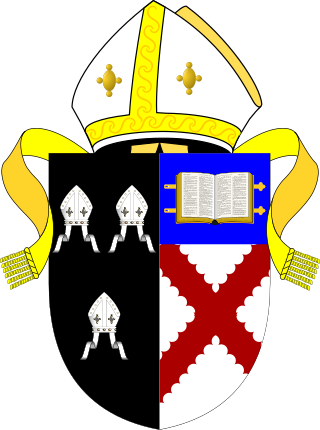The Diocese of Meath is a nineteenth-century publication on the history of the Roman Catholic Diocese of Meath from medieval to nineteenth century times, written by one of the Diocese's priests, Dean Cogan, a priest in Navan, the then Diocesan capital.
Bohermeen is a Roman Catholic parish in the Irish Diocese of Meath. Its English name is a corruption of an ancient Irish language name, An Bóthar Mín, which meant the smooth road. Originally one of the five famed ancient roadways that led from the mediaeval capital of Ireland, Tara, approximately 10 miles away cut through the area. The quality of the roadway, in an era of dirt-roads, earned for it the nickname of the smooth road, An Bóthar Mín.

St Finian's College is a secondary school, the diocesan school of the Diocese of Meath. It is located in Mullingar, County Westmeath, Ireland, and is under the patronage of The Most Reverend Thomas Deenihan, Bishop of Meath. Rev. Dr. Paul Connell is its president. John McHale is the principal. Aisling Ryan and Emma Carey serve as deputy principals.

The Missionary Society of St. Columban, commonly known as the Columbans, is a missionary Catholic society of apostolic life of Pontifical Right founded in Ireland in 1917 and approved by the Vatican in 1918. Initially it was known as the Maynooth Mission to China. Members may be priests, seminarians or lay workers. Fr John Blowick, one of the two founders of the Society, also founded the Missionary Sisters of St. Columban to share in their work. The society is dedicated to St. Columbanus. The current international headquarters is in Hong Kong.

The Diocese of Meath is a Latin Church diocese of the Catholic Church that is located in the middle part of Ireland. It is one of eight suffragan dioceses of the ecclesiastical province of Armagh. Thomas Deenihan has been bishop of the diocese since 2 September 2018.

Dermot Pius Farrell KC*HS is an Irish Roman Catholic prelate who has served as Archbishop of Dublin since 2021.

The Diocese of Kilmore is a Latin Church diocese which is mainly in the Republic of Ireland although a few parishes are in Northern Ireland. It is one of eight suffragan dioceses which are subject to the Metropolitan Archdiocese of Armagh.

The United Dioceses of Meath and Kildare is a diocese in the Church of Ireland located in the Republic of Ireland. The diocese is in the ecclesiastical province of Dublin. Alone of English and Irish bishops who are not also archbishops, the Bishop of Meath and Kildare is styled "The Most Reverend".

Andrew J. Byrne was an Irish-born American Catholic priest, who became the first bishop of the Diocese of Little Rock in Arkansas from 1844 until his death in 1862.
Father Patrick Tully was a well-known figure in Meath GAA circles, particularly for his training of Meath Gaelic football teams of 1949, 1954 and 1967 to All Ireland Senior titles. Prior to the 1949 win Meath had never won a Senior All Ireland Title. Fr Tully was educated at Kentstown National School, St Finian's College, Mullingar and St. Patrick's College, Maynooth, where he was ordained a priest in 1942 and subsequently served in a number of parishes in the Meath dioceses when in 1948 he was posted to Moynalty. While based here he was elected County Board Chairman in 1949, a post he held for 20 years and combined this with training the Meath Senior football team.
James Dillon (1738–1806) was an Irish Roman Catholic Bishop of Kilmore from 1800 to 1806.

St Patrick's Classical School is a Roman Catholic-run school for boys in Navan, County Meath. It has produced a number of politicians, journalists, Irish sports personalities, broadcasters and two winners of the Perrier Comedy Award at the Edinburgh Fringe.
The Diocese of UK, Europe and Africa is one of the 30 dioceses of the Malankara Orthodox Syrian Church with its headquarters in London.

Denis Nulty KC*HS is an Irish Roman Catholic prelate who has served as Bishop of Kildare and Leighlin since 2013.
Bishop John Cantwell was a Roman Catholic Bishop of Meath.
Bishop Mathew Gaffney was a Roman Catholic Bishop of Meath.
Thomas Mulvany was the Roman Catholic Bishop of Meath, Ireland from 1929 to his death in 1943.
Laurence Gaughran was the Roman Catholic Bishop of Meath, Ireland from 1906 until his death.

Paul Connell is an Irish Roman Catholic priest who was appointed Bishop-elect of Ardagh and Clonmacnoise on 5 April 2023.













